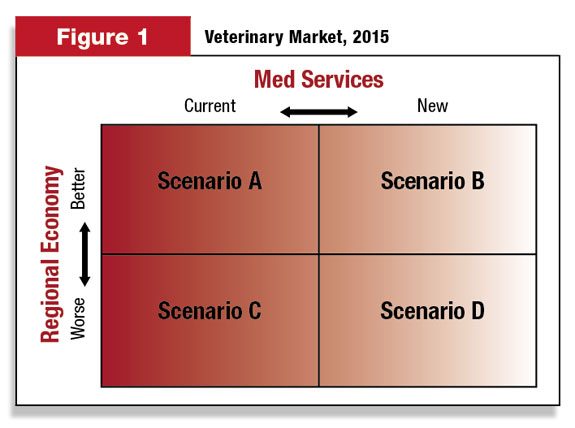Looking back, U.S. agricultural industries have changed dramatically over the past decade. Given mounting political, social, technological and economic pressures, it is safe to assume not only that change will continue, but that it could even increase in rapidity.
Looking forward, how will future veterinary practices succeed? For example, how will vets respond if:
- States, facing ever-increasing budgetary shortfalls, effectively eliminate enforcement of their veterinary practice acts?
- New technologies, administered by non-DVMs, replace current practices?
- Large-scale corporate ownership of operations outpaces the current rate of consolidations in the poultry, swine and feedlot industries, with these mega-operations employing their own vets – both foreign and domestic?
Good strategies seek “sustainable competitive advantage,” as Michael Porter outlined in the 1970s.
While any business can meet short-term needs by cutting costs, reducing offerings or playing cash management games, these are, at best, short-term responses to changing markets or increasing competition. Strategies that succeed over the long term answer two questions:
- Where to play: What markets, channels, geographies are we focusing on?
- How to win: Within those target markets and segments, why will anyone choose us over the competition?
Players in all markets struggle with these questions. For example, Cisco in April of this year closed down its Flip video business – an operation it bought a mere two years earlier for $590 million – in order to “align operations in support of our network-centric platform strategy,” according to John T. Chambers, Cisco’s chief executive.
As reported laconically by The New York Times, “Even in the life cycle of the tech world, this is fast.”
Companies large and small are often unwilling to, at least, discuss: What could really change in the future?
And are we ready to respond? When looking forward and trying to understand where to focus and how to win, as Jeff Bezos, the CEO of Amazon, said, “There is a tendency for executives to think the right course of action is to stick to the knitting – stick with what you are good at.
That may be a generally good rule, but the problem is that the world changes out from under you.”
Failures of strategy are too often failures to anticipate a reality different from what we are prepared or willing to see.
As Nassim Taleb asks in his provocative book, Black Swan, just because we have not seen a black swan does not mean they do not exist, and unfortunately, those “unforeseen” events are just what really challenge the likelihood of ongoing survival and prosperity.
So how best to challenge “prevailing wisdom” and assess emerging opportunities and threats? One tool is scenario planning.
Scenarios are portrayals of a series of plausible alternative futures. Each scenario tells a story of how various forces might interact under certain conditions.
They are designed to open up new ways of thinking about the future, providing a framework for strategic dialogue – new questions, new conversations – as the basis for strategic action.
Scenarios are not a prediction or forecast; rather, they seek to create a reasonable range of “future worlds” that allow for testing the risks and rewards of current direction.
Scenarios of the future for veterinary practices
Veterinary practices in most areas of the U.S. face ever-increasing challenges with the evolution of domestic livestock industries.
As an example of how scenarios can help strategy decisions for vets specifically, below is one possible range of futures for large and small veterinary practices in the U.S.
Even though there are literally thousands of potential futures, two major uncertainties that will certainly affect the growth potential for vet practices are regional agricultural economies as well as the level and type of veterinary medical services.

These two uncertainties – regional ag economy and medical services – “frame” four potential futures, as illustrated in Figure 1.
Scenario A, for example, would be similar to today’s environment, projected forward into 2015.
However, Scenario D, possibly the most challenging to current vet practices, outlines a diminished economic environment for livestock operations and much more competitive, low-cost medical services, increasingly employed by and for large-animal operations themselves.
Scenario B, on the other hand, envisions a potential future where livestock producers are doing well, buoyed by rising milk and beef prices, lower feed costs and growing demand for their output products (possibly as a result of efforts to reduce soft drink consumption or aggressively expand into world export markets, for example).
Yet, new medical technologies such as lower-cost disease identification and treatment options, could disrupt current vet operations.
Scenario C is likewise not a “happy” world: Livestock margins erode, ag communities face increasing environmental pressures, all impacting the growth and margins of vet operations.
The typical reaction when presented a range of potential futures is to try and guess which future is more likely, especially if they challenge what we see today. But as indicated, scenarios are not predictors; rather, they outline a range of possible outcomes for veterinarians and their clients to assess:
- Where might there be unforeseen opportunities and threats?
- What should my practice be prepared for ... and how might we be “blindsided?”
Given our current strategy, is it sustainable across multiple different futures, or is it really predicated on “running harder” in the current world? What happens if things then change?
Implications
Coming up with different future “worlds” is fun and challenging, but the real value in scenario planning is in helping expand the possibilities for growth, while protecting against “external shocks.”
So with the set of possible futures outlined above, how might the vet practice of the future respond? Specifically, in Scenario A:
- Work hard, possibly adding staffs.
- See if you can raise prices and expand your client base.
Assuming your operation is profitable today, Scenario A is clearly the “best” of the futures presented. The most challenging one, Scenario D, has very different implications for success:
- Emphasize consulting and preventative care, targeting a few, large customers.
- Employ fewer, less expensive staff.
- Focus on more protocol-driven practices, possibly located on-site of major clients.
- Seek to establish “value” for your customers, as they define it, even if this means doing more for less.
As for the other two scenarios, in Scenario B, successful vet practices may be built around flexible contracting and delivery arrangements between vets and their main clients.
Should vets look to do more than simply supply medical services, such as expanding into management and operational advisers, adding staffs in milking operations and quality, for example?
In the world outlined by Scenario C, where producers are struggling, lowering the costs of support for primary customers will be critical.
Potential winning strategies might involve agreeing outcome measurements tied to payments.
The question then is not, “Which of these worlds will happen?” but rather, “What do we need to do (or be ready to do) to be successful no matter what the future brings?”
Or perhaps, “Are we ready to move if Scenario A, where we are today, starts morphing into one of the other scenarios?”
While these ideas may not be relevant today, given the potential for continued feed cost increases and lower beef prices over the next several years, prescient vet practices will want, at the very least, to experiment with some of these options.
In summary, scenario planning does three things:
- Starts the strategic discussion by looking at a reasonable range of alternative futures.
- Asks the question across all four potential scenarios: What is the “ideal” organization, and its specific characteristics, that will enable the vet practice of the future to prosper no matter which future occurs.
- Tests the current organization against the “ideal” situation to develop a set of strategic priorities for the (uncertain) future. This helps owners think through “what if” options.
- Ideally, while current vet practices continue (assuming they are profitable today), a few alternatives or experiments might be added, just in case.
Wayne Wagner writes that when faced with rapidly changing environments, “We walk backward into the future, with our minds anchored by the imprinted lessons of the past.”
Scenario planning starts from the future and works back and, in that process, ideally reveals more creative opportunities for sustainable veterinary practice success.
This article originally appeared in Progressive Dairyman magazine.






